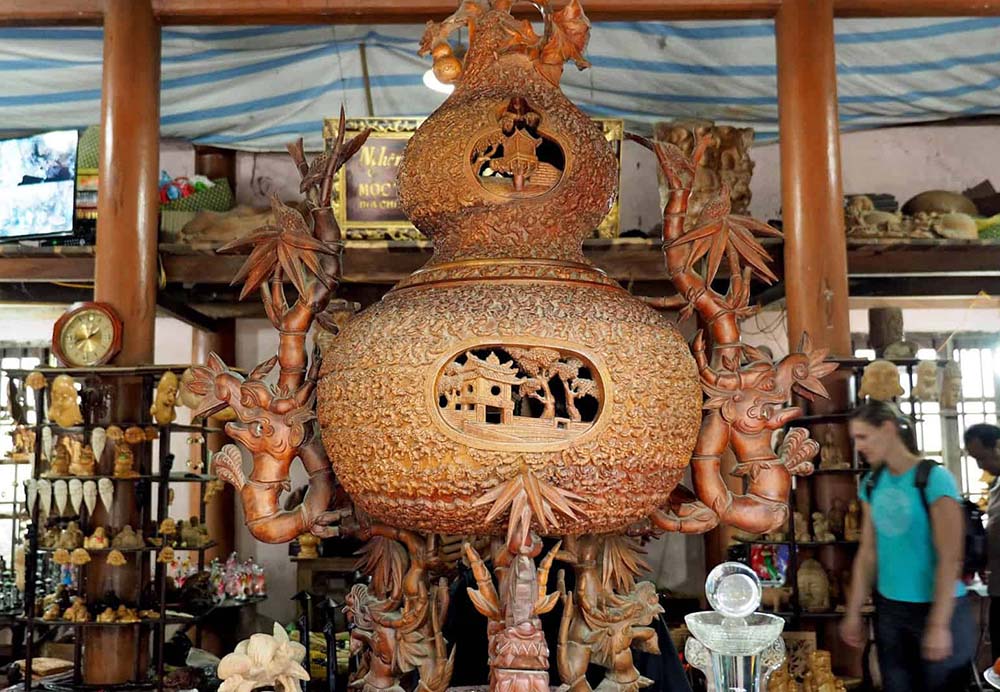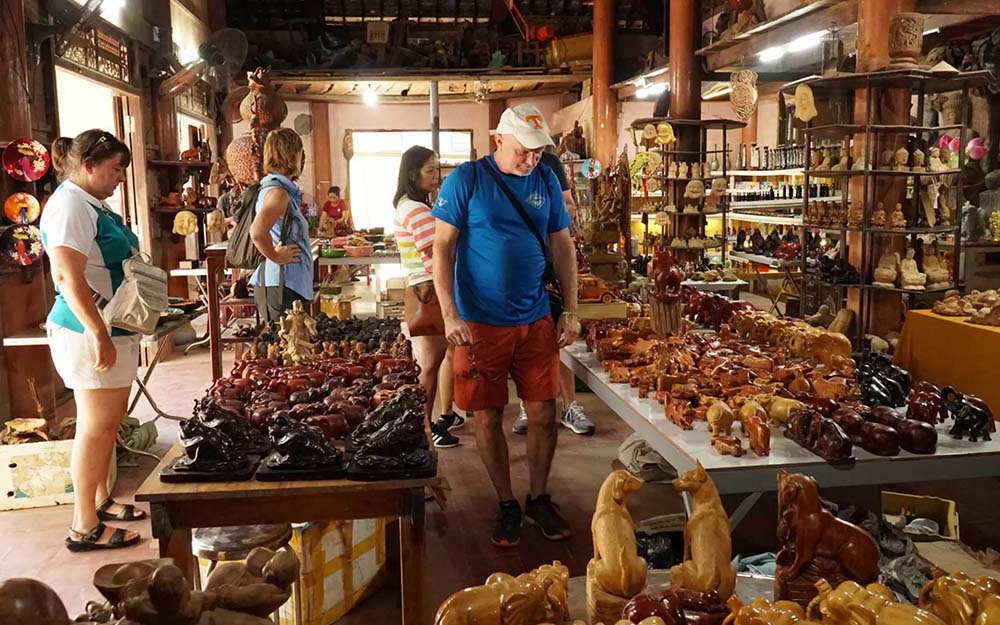Immerse yourself in the centuries-old craftsmanship of Kim Bong Carpentry Village in Hoi An, Vietnam. Explore the village's rich woodworking heritage, witness skilled artisans at work, and discover the intricate wooden products that have made this village famous.
List of Contents
- 1. A Brief History of Kim Bong Carpentry Village
- 2. Kim Bong Carpentry Village Location
- 3. Highlights of Kim Bong Carpentry Village
- 4. Things to Do in Kim Bong Carpentry Village
- 5. Ticket Price and Opening Hours of Hoi An Kim Bong Carpentry Village
- 6. Best Time To Visit Kim Bong Village
- 7. How To Get To Kim Bong Carpentry Village
- 8. Extra Tips on Traveling Kim Bong Carpentry Village
1. A Brief History of Kim Bong Carpentry Village

For 600 years, the woodworking community has weathered changes alongside Hoi An City. Three main periods mark its journey:
1.1. The Old Village
Since the late 15th century, Kim Bong Carpentry Village has endured. Its traditional craftsmanship lives on, a testament to Vietnamese culture. The village once bore the name Kim Bong Chau. Its people hailed from the north and north-central regions, mainly Thanh Hoa and Nghe An.
Four families – Nguyen, Chuong, Phan, and Huynh – mastered the woodworking trade. Their skills produced everything from daily items to grand buildings.
The village's communal house honored carpentry ancestors. One Huynh family member even helped build the Ho Chi Minh Mausoleum in Hanoi.
1.2. The Prosperity of Kim Bong Village
The villagers' talent shone through their first handcrafted objects. Their fame spread to Hue, leaving marks on royal buildings there and in Hoi An.
The 17th century brought a boom as Hoi An's port thrived. Demand for ships and infrastructure soared. Some say they built 20-ton vessels. Kim Bong craftsmanship became Hoi An's hallmark.
1.3. The Urbanization of Kim Bong Carpentry Village
Time marched on, but Kim Bong artisans adapted. They blend tradition with Western designs. Their work still shapes Hoi An, restoring religious sites and historical relics.
Notable creations include a 1000-dragon censer for Hanoi's Thang Long celebration and a replica of the Hoi An Japanese Bridge.
2. Kim Bong Carpentry Village Location
Location and Address of Kim Bong Carpentry Village
- Address: Nong Thon Street, Trung Ha Hamlet, Cam Kim Commune, Hoi An City, Quang Nam Province
- Location:
- Situated on Cam Kim Island, on the right bank of the Thu Bon River downstream
- The Thu Bon River flows through Hoi An City before pouring into the ocean
- Approximately 7 kilometers from Hoi An Ancient Town on the opposite bank of the river
3. Highlights of Kim Bong Carpentry Village

3.1. Traditional Kim Bong Woodworking
- The village's trade is divided into three main categories: wood architecture, shipbuilding, and usual carpentry.
- Kim Bong artisans have contributed to the construction of most buildings in Hoi An, including houses, family worship houses, and ancient temples.
- The village's artisans also played a significant role in constructing the distinguished architecture of Hue Citadel during the Nguyen Dynasty.
- Kim Bong woodworkers' rustic and soulful sculptures, imbued with long-standing tradition, capture the hearts of every tourist.
- The carvings from Kim Bong Village vividly reflect the cultural values, power, energy, prosperity, and long-lasting history of Hoi An.
3.2. Ancient Architecture of Kim Bong Village
- The village itself is a highlight for tourists, with its rustic yet beautiful and majestic buildings.
- The beauty of the village's architecture lies in its time-honored longevity and proud traditions.
- Visitors may be astonished to find familiar buildings similar to those in Hoi An, as Kim Bong craftsmen designed and carved almost all the celebrated wooden constructions in the ancient town.
- The village attracts many domestic and foreign tourists annually, especially those who admire the buildings in Hoi An Ancient Town and are curious about their creators.
3.3. Convenient Location
- Kim Bong Carpentry Village is easily accessible, located just a 10-minute ride from Hoi An Ancient Town.
- The convenient location makes it easy for tourists to visit the village without hesitation.
- The accessibility also facilitates the import of raw materials for woodworking and the export of Kim Bong wood products to other places nationwide and worldwide.
- The village's traditional trade survives and thrives, thanks in part to its convenient location.
4. Things to Do in Kim Bong Carpentry Village

The woodworking community offers a rich experience. Here's what visitors can do:
4.1. Admire the Beautiful Carvings
- The village is divided into two areas: the western area for handicrafts and the eastern area for shipbuilding.
- Visitors can see a wide range of intricate carvings, such as wooden animals, Buddha statues, Guan Yin statues, and images depicting the everyday life of Hoi An and Vietnam.
- The exquisite carvings showcase the passion and skill of Kim Bong woodworkers, carrying the Vietnamese soul in each piece.
4.2. Learn the Process of Making a Carpentry Product
- Tourists can take a tour and observe the woodworking process firsthand, from small animals to giant statues for pagodas and temples.
- Visitors will be fascinated by the souvenir shops showcasing the artisans' work.
4.3. Visit the 600-Year-Old Kim Bong Carpentry Village
- Developed in the 15th century, Kim Bong Carpentry Village is the oldest Hoi An craft village.
- The village has preserved its traditional atmosphere and adapted to new changes.
- Visitors can explore the western area for artistic carvings and the eastern area for shipbuilding.
- Discovering the village by bike allows visitors to experience the daily lives of local people and participate in activities like bamboo and mat weaving and rice cake making.
4.4. Watch the Woodworking of Kim Bong Artisans
- Observe the step-by-step production process of a wood piece, from shaping the raw log to adding sophisticated decorations.
- Witness the artisans' tireless efforts in creating high-quality, culturally valuable pieces.
4.5. Enjoy Hoi An Specialties
- Visit nearby restaurants to savor famous Hoi An dishes like Quang noodles, pancakes, Cao Lau, chicken rice, Phuong bread, and stir-fried mussels.
- Enjoy snacks such as sweet popiah, ice cream, or baked potato cakes.
4.6. Buy Souvenirs
- Purchase fine arts items, couplets, decorative, or religious items from the village's souvenir shops.
- Bring home an artwork to preserve memories of your visit to Kim Bong Carpentry Village.
- Take advantage of the reasonable prices for products and souvenirs.
5. Ticket Price and Opening Hours of Hoi An Kim Bong Carpentry Village
Entrance Fee and Opening Hours
- The entrance to Kim Bong Carpentry Village is free. Visitors only need to pay for personal expenses, such as food, drinks, and souvenirs.
- Kim Bong Carpentry Village is open 24 hours a day, 7 days a week, allowing you to visit at any time that suits your schedule.
6. Best Time To Visit Kim Bong Village
The best time to visit Kim Bong Village is during the dry season, from February to August, with the most pleasant weather occurring between April and June. Since most of your time will be spent outdoors, choose a sunny day for your visit.
Consider visiting on the 6th day of the first lunar month, when the village holds a big feast for their ancestor commemoration. During this time, various interesting activities imbued with local cultural features take place.
As Kim Bong Village is part of the Hoi An tourist area, the most suitable time to visit depends heavily on Hoi An's weather and climate. Since the final products in Kim Bong are made of wood, it is better to visit during the dry season (March-September) when there is little rain.
7. How To Get To Kim Bong Carpentry Village

Kim Bong Village is conveniently located opposite Hoi An Ancient Town. There are several transportation options for your visit:
- Motorcycle: Cross the 600-meter Cam Kim Bridge and turn left. Travel 3 kilometers to reach Kim Bong Village.
- Boat: Take a 10-minute boat trip from Hoi An Ancient Town's boat dock (along Bach Dang Street) to the south. Take a Hoi An – Cam Kim boat and walk a short distance to reach the village.
- Car rental (from Da Nang): Rent a car with door-to-door service in Da Nang. Prices start at 300,000 VND (14 USD) per car per day. Drive to Hoi An and then to Kim Bong Village.
- Public transport: Take a bus from Da Nang to Hoi An. Rent a cyclo or bicycle to travel to Kim Bong.
- Taxi/Grab: A safe and suitable choice for families with young children or the elderly. Prices are around 350,000 VND (15.00 USD) per way.
As one of the most traditional craft villages in Hoi An, visiting Kim Bong Carpentry Village is definitely one of the things not to be missed in Hoi An for tourists who love Vietnamese culture.
Consider places to stay in Hoi An before visiting for the most convenient trip. As one of the most traditional craft villages in Hoi An, visiting Kim Bong Carpentry Village is a must-do activity for tourists who love Vietnamese culture.
8. Extra Tips on Traveling Kim Bong Carpentry Village
- Check the weather forecast to avoid traveling in the stormy and rainy season, which deter you against joining in outdoor activities
- Dressing casually, because the village is considered the countryside with traditional habits and costumes. The village entrance is free of charge
- The tour is suitable for a family trip, especially for children. They could widen their horizon about history as well as a valuable culture of Vietnam.
- There are numerous means of transportation at a very reasonable price you could you to travel there
After exploring the wood carving traditions of Kim Bong Carpentry Village, dive deeper into the charms of Hoi An. Our Hoi An Travel Guide and Things to Do in Hoi An articles reveal the best attractions, activities and experiences in this enchanting ancient town.
And just a short boat ride away, rustic Cam Kim Island offers a peaceful escape amidst lush countryside and centuries-old crafts villages. Plan your perfect Hoi An trip with our expert guides.






